2015 FIAT GRANDE PUNTO ACTUAL tow
[x] Cancel search: towPage 115 of 216
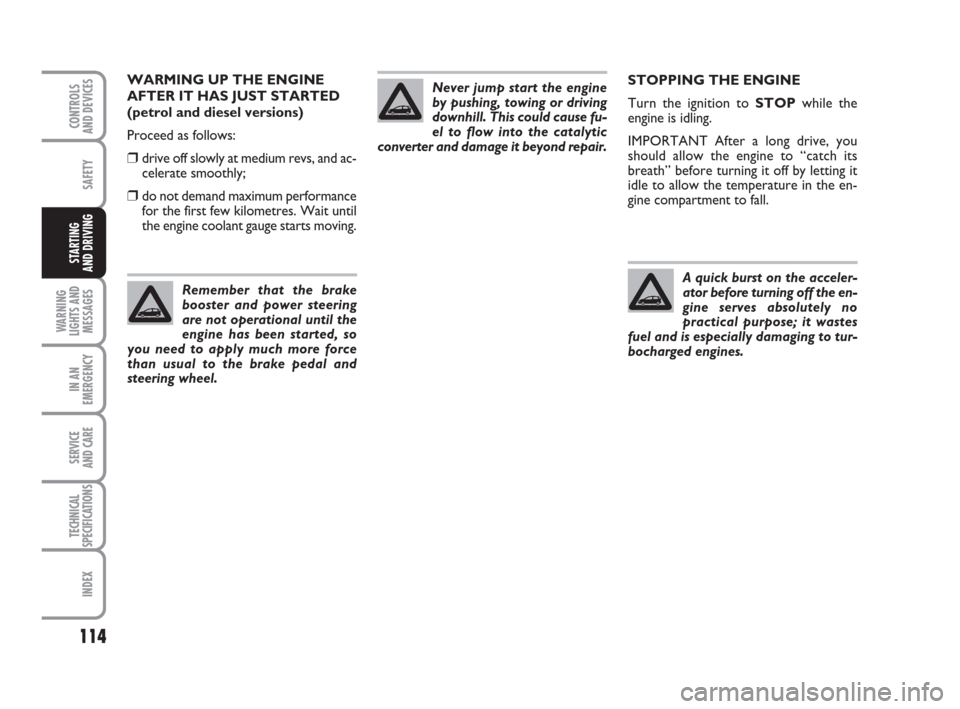
114
SAFETY
WARNING
LIGHTS AND
MESSAGES
IN AN
EMERGENCY
SERVICE
AND CARE
TECHNICAL
SPECIFICATIONS
INDEX
CONTROLS
AND DEVICES
STARTING
AND DRIVING
STOPPING THE ENGINE
Turn the ignition to STOPwhile the
engine is idling.
IMPORTANT After a long drive, you
should allow the engine to “catch its
breath” before turning it off by letting it
idle to allow the temperature in the en-
gine compartment to fall.
A quick burst on the acceler-
ator before turning off the en-
gine serves absolutely no
practical purpose; it wastes
fuel and is especially damaging to tur-
bocharged engines.WARMING UP THE ENGINE
AFTER IT HAS JUST STARTED
(petrol and diesel versions)
Proceed as follows:
❒drive off slowly at medium revs, and ac-
celerate smoothly;
❒do not demand maximum performance
for the first few kilometres. Wait until
the engine coolant gauge starts moving.
Remember that the brake
booster and power steering
are not operational until the
engine has been started, so
you need to apply much more force
than usual to the brake pedal and
steering wheel.
Never jump start the engine
by pushing, towing or driving
downhill. This could cause fu-
el to flow into the catalytic
converter and damage it beyond repair.
111-122 ACTUAL 1ed EN 20-07-2010 16:10 Pagina 114
Page 118 of 216
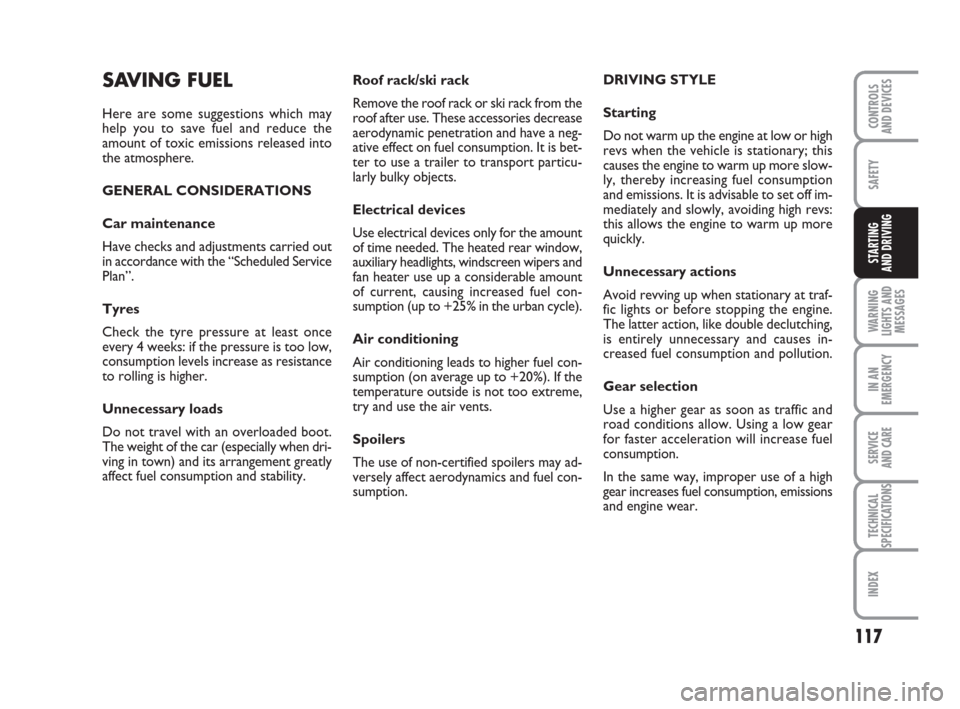
117
SAFETY
WARNING
LIGHTS AND
MESSAGES
IN AN
EMERGENCY
SERVICE
AND CARE
TECHNICAL
SPECIFICATIONS
INDEX
CONTROLS
AND DEVICES
STARTING
AND DRIVING
Roof rack/ski rack
Remove the roof rack or ski rack from the
roof after use. These accessories decrease
aerodynamic penetration and have a neg-
ative effect on fuel consumption. It is bet-
ter to use a trailer to transport particu-
larly bulky objects.
Electrical devices
Use electrical devices only for the amount
of time needed. The heated rear window,
auxiliary headlights, windscreen wipers and
fan heater use up a considerable amount
of current, causing increased fuel con-
sumption (up to +25% in the urban cycle).
Air conditioning
Air conditioning leads to higher fuel con-
sumption (on average up to +20%). If the
temperature outside is not too extreme,
try and use the air vents.
Spoilers
The use of non-certified spoilers may ad-
versely affect aerodynamics and fuel con-
sumption.DRIVING STYLE
Starting
Do not warm up the engine at low or high
revs when the vehicle is stationary; this
causes the engine to warm up more slow-
ly, thereby increasing fuel consumption
and emissions. It is advisable to set off im-
mediately and slowly, avoiding high revs:
this allows the engine to warm up more
quickly.
Unnecessary actions
Avoid revving up when stationary at traf-
fic lights or before stopping the engine.
The latter action, like double declutching,
is entirely unnecessary and causes in-
creased fuel consumption and pollution.
Gear selection
Use a higher gear as soon as traffic and
road conditions allow. Using a low gear
for faster acceleration will increase fuel
consumption.
In the same way, improper use of a high
gear increases fuel consumption, emissions
and engine wear.SAVING FUEL
Here are some suggestions which may
help you to save fuel and reduce the
amount of toxic emissions released into
the atmosphere.
GENERAL CONSIDERATIONS
Car maintenance
Have checks and adjustments carried out
in accordance with the “Scheduled Service
Plan”.
Tyres
Check the tyre pressure at least once
every 4 weeks: if the pressure is too low,
consumption levels increase as resistance
to rolling is higher.
Unnecessary loads
Do not travel with an overloaded boot.
The weight of the car (especially when dri-
ving in town) and its arrangement greatly
affect fuel consumption and stability.
111-122 ACTUAL 1ed EN 20-07-2010 16:10 Pagina 117
Page 119 of 216

118
SAFETY
WARNING
LIGHTS AND
MESSAGES
IN AN
EMERGENCY
SERVICE
AND CARE
TECHNICAL
SPECIFICATIONS
INDEX
CONTROLS
AND DEVICES
STARTING
AND DRIVING
CONDITIONS OF USE
Cold starting
Short distances and frequent cold start-
ups will prevent the engine from reach-
ing optimal running temperature. Conse-
quently, both fuel consumption (from +15
to +30% on the urban cycle) and emis-
sions will increase.
Traffic and road
conditions
Heavy traffic, for instance when travelling
in a queue with frequent use of low gears
or in cities with lots of traffic lights, caus-
es fairly high fuel consumption. Mountain
roads and uneven surfaces also have a neg-
ative effect on consumption.
Traffic hold-ups
During prolonged hold-ups (e.g. at level
crossings) the engine should be switched
off.TOWING TRAILERS
IMPORTANT NOTES
The car must be equipped with an ap-
proved tow hook and adequate electrical
system to tow caravans or trailers. Instal-
lation must be performed by specialised
personnel who will issue the required pa-
pers for travelling on roads.
Install any specific and/or additional rear
view mirrors in accordance with the high-
way code of the country in which you are
travelling.
Remember that, when towing a trailer,
steep hills are harder to climb, braking dis-
tances increase and overtaking takes
longer relative to the overall weight of the
trailer.
Engage a low gear when driving downhill,
rather than constantly using the brake.
The weight of the trailer on the car’s tow
hook will reduce the load capacity of the
car by the same amount. Consider the
weight of the trailer fully laden, including
accessories and luggage, to make sure you
do not exceed the maximum towable
weight (shown on the vehicle registration
document). Top speed
Fuel consumption considerably increases
as speed increases. Keep your speed as
even as possible, avoiding unnecessary
braking and acceleration, which cause ex-
cessive fuel consumption and increased
emissions.
Acceleration
Accelerating violently severely affects con-
sumption and emissions: acceleration
should be gradual and should not exceed
the maximum torque.
111-122 ACTUAL 1ed EN 20-07-2010 16:10 Pagina 118
Page 120 of 216
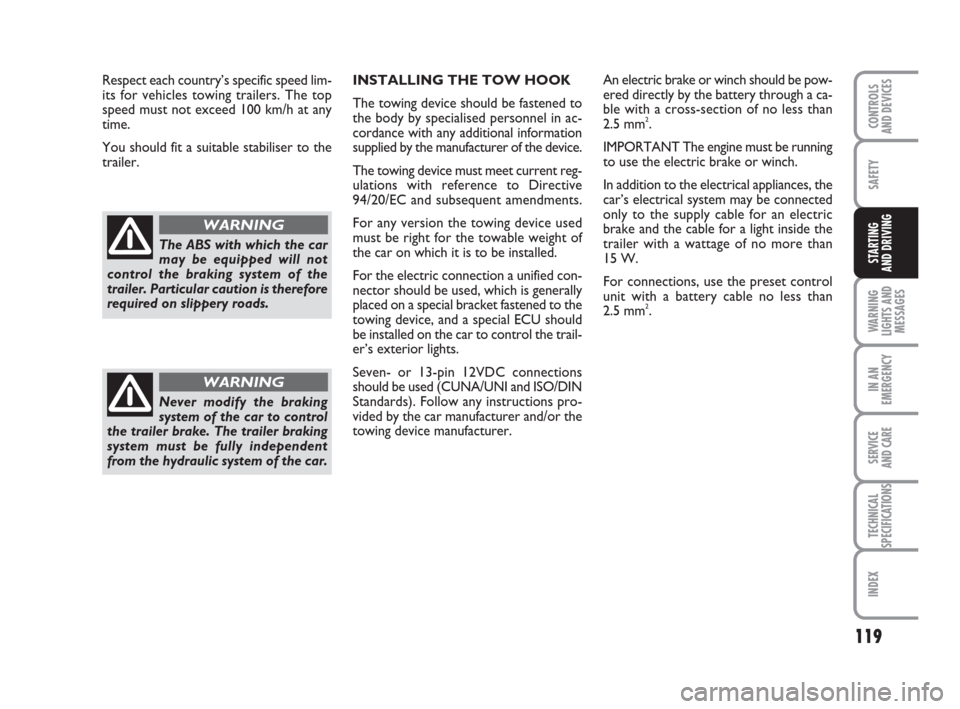
119
SAFETY
WARNING
LIGHTS AND
MESSAGES
IN AN
EMERGENCY
SERVICE
AND CARE
TECHNICAL
SPECIFICATIONS
INDEX
CONTROLS
AND DEVICES
STARTING
AND DRIVING
INSTALLING THE TOW HOOK
The towing device should be fastened to
the body by specialised personnel in ac-
cordance with any additional information
supplied by the manufacturer of the device.
The towing device must meet current reg-
ulations with reference to Directive
94/20/EC and subsequent amendments.
For any version the towing device used
must be right for the towable weight of
the car on which it is to be installed.
For the electric connection a unified con-
nector should be used, which is generally
placed on a special bracket fastened to the
towing device, and a special ECU should
be installed on the car to control the trail-
er’s exterior lights.
Seven- or 13-pin 12VDC connections
should be used (CUNA/UNI and ISO/DIN
Standards). Follow any instructions pro-
vided by the car manufacturer and/or the
towing device manufacturer.An electric brake or winch should be pow-
ered directly by the battery through a ca-
ble with a cross-section of no less than
2.5 mm
2.
IMPORTANT The engine must be running
to use the electric brake or winch.
In addition to the electrical appliances, the
car’s electrical system may be connected
only to the supply cable for an electric
brake and the cable for a light inside the
trailer with a wattage of no more than
15 W.
For connections, use the preset control
unit with a battery cable no less than
2.5 mm
2. Respect each country’s specific speed lim-
its for vehicles towing trailers. The top
speed must not exceed 100 km/h at any
time.
You should fit a suitable stabiliser to the
trailer.
The ABS with which the car
may be equipped will not
control the braking system of the
trailer. Particular caution is therefore
required on slippery roads.
WARNING
Never modify the braking
system of the car to control
the trailer brake. The trailer braking
system must be fully independent
from the hydraulic system of the car.
WARNING
111-122 ACTUAL 1ed EN 20-07-2010 16:10 Pagina 119
Page 121 of 216

120
SAFETY
WARNING
LIGHTS AND
MESSAGES
IN AN
EMERGENCY
SERVICE
AND CARE
TECHNICAL
SPECIFICATIONS
INDEX
CONTROLS
AND DEVICES
STARTING
AND DRIVING
Assembly diagram fig. 3
The tow hook structure must be fastened
at the points marked by
Øusing a total
of 6 M10 screws.
The internal back plates should be at least
6 mm thick.
The hook should be fastened to the body
avoiding any type of drilling of the rear
bumper that remains visible when the
hook is removed.
IMPORTANT It is compulsory to attach
a label (plainly visible) of suitable size and
material at the same level as the hitch ball,
with the following wording:
MAX LOAD ON BALL 60 kg
After assembly, the screw
holes should be sealed to
prevent exhaust gases getting in.
WARNING
fig. 3F0M0143m
Existing
hole
Existing
screw
Existing screw
Existing
holeExisting
hole
Existing hole
Standard ball
Laden
111-122 ACTUAL 1ed EN 20-07-2010 16:10 Pagina 120
Page 127 of 216
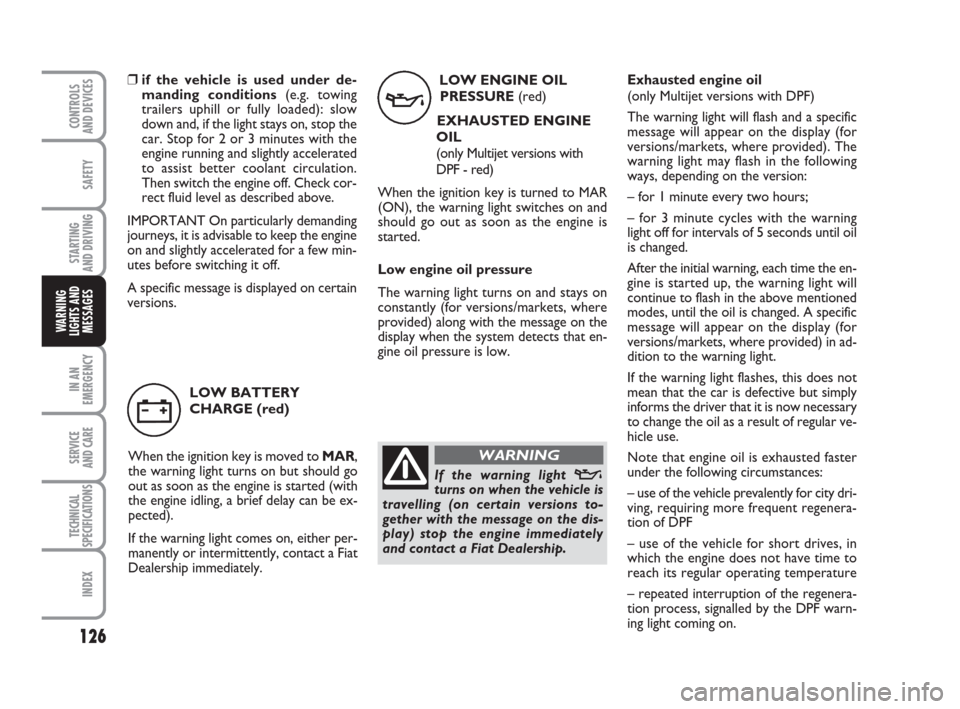
126
SAFETY
STARTING
AND DRIVING
IN AN
EMERGENCY
SERVICE
AND CARE
TECHNICAL
SPECIFICATIONS
INDEX
CONTROLS
AND DEVICES
WARNING
LIGHTS AND
MESSAGES
LOW ENGINE OIL
PRESSURE (red)
EXHAUSTED ENGINE
OIL
(only Multijet versions with
DPF - red)
When the ignition key is turned to MAR
(ON), the warning light switches on and
should go out as soon as the engine is
started.
Low engine oil pressure
The warning light turns on and stays on
constantly (for versions/markets, where
provided) along with the message on the
display when the system detects that en-
gine oil pressure is low.
v
If the warning light vturns on when the vehicle is
travelling (on certain versions to-
gether with the message on the dis-
play) stop the engine immediately
and contact a Fiat Dealership.
WARNING
❒if the vehicle is used under de-
manding conditions (e.g. towing
trailers uphill or fully loaded): slow
down and, if the light stays on, stop the
car. Stop for 2 or 3 minutes with the
engine running and slightly accelerated
to assist better coolant circulation.
Then switch the engine off. Check cor-
rect fluid level as described above.
IMPORTANT On particularly demanding
journeys, it is advisable to keep the engine
on and slightly accelerated for a few min-
utes before switching it off.
A specific message is displayed on certain
versions.
LOW BATTERY
CHARGE (red)
When the ignition key is moved to MAR,
the warning light turns on but should go
out as soon as the engine is started (with
the engine idling, a brief delay can be ex-
pected).
If the warning light comes on, either per-
manently or intermittently, contact a Fiat
Dealership immediately.
w
Exhausted engine oil
(only Multijet versions with DPF)
The warning light will flash and a specific
message will appear on the display (for
versions/markets, where provided). The
warning light may flash in the following
ways, depending on the version:
– for 1 minute every two hours;
– for 3 minute cycles with the warning
light off for intervals of 5 seconds until oil
is changed.
After the initial warning, each time the en-
gine is started up, the warning light will
continue to flash in the above mentioned
modes, until the oil is changed. A specific
message will appear on the display (for
versions/markets, where provided) in ad-
dition to the warning light.
If the warning light flashes, this does not
mean that the car is defective but simply
informs the driver that it is now necessary
to change the oil as a result of regular ve-
hicle use.
Note that engine oil is exhausted faster
under the following circumstances:
– use of the vehicle prevalently for city dri-
ving, requiring more frequent regenera-
tion of DPF
– use of the vehicle for short drives, in
which the engine does not have time to
reach its regular operating temperature
– repeated interruption of the regenera-
tion process, signalled by the DPF warn-
ing light coming on.
123-134 ACTUAL 1ed EN 31-08-2010 9:23 Pagina 126
Page 136 of 216
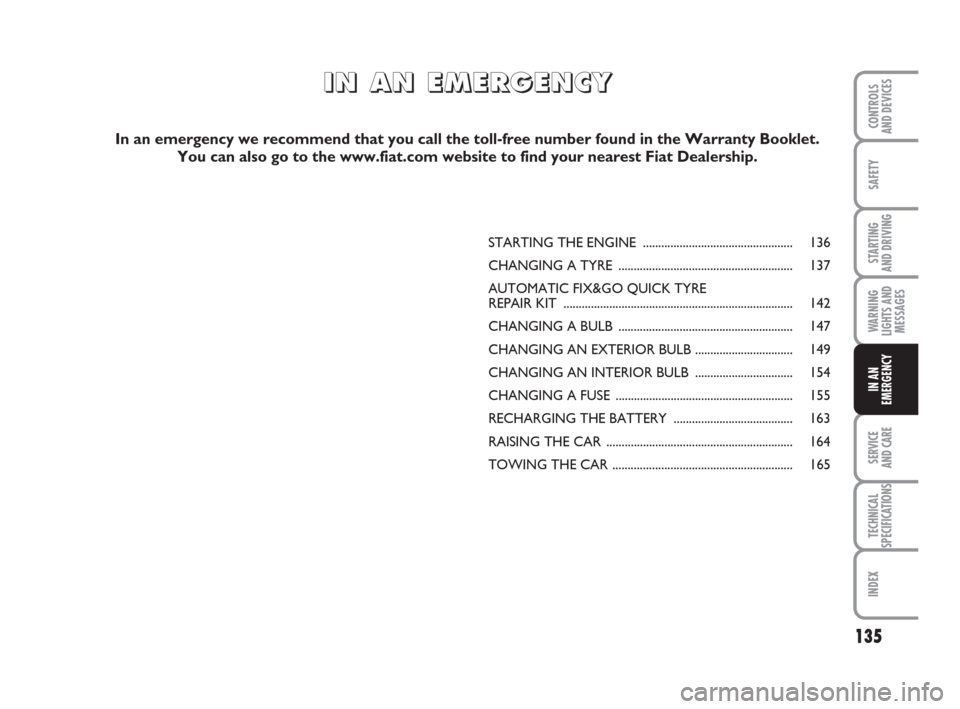
135
SAFETY
STARTING
AND DRIVING
WARNING
LIGHTS AND
MESSAGES
SERVICE
AND CARE
TECHNICAL
SPECIFICATIONS
INDEX
CONTROLS
AND DEVICES
IN AN
EMERGENCY
STARTING THE ENGINE ................................................. 136
CHANGING A TYRE ......................................................... 137
AUTOMATIC FIX&GO QUICK TYRE
REPAIR KIT ........................................................................... 142
CHANGING A BULB ......................................................... 147
CHANGING AN EXTERIOR BULB ................................ 149
CHANGING AN INTERIOR BULB ................................ 154
CHANGING A FUSE .......................................................... 155
RECHARGING THE BATTERY ....................................... 163
RAISING THE CAR ............................................................. 164
TOWING THE CAR ........................................................... 165
I I
N N
A A
N N
E E
M M
E E
R R
G G
E E
N N
C C
Y Y
In an emergency we recommend that you call the toll-free number found in the Warranty Booklet.
You can also go to the www.fiat.com website to find your nearest Fiat Dealership.
135-166 ACTUAL 1ed EN 26-07-2010 16:00 Pagina 135
Page 137 of 216
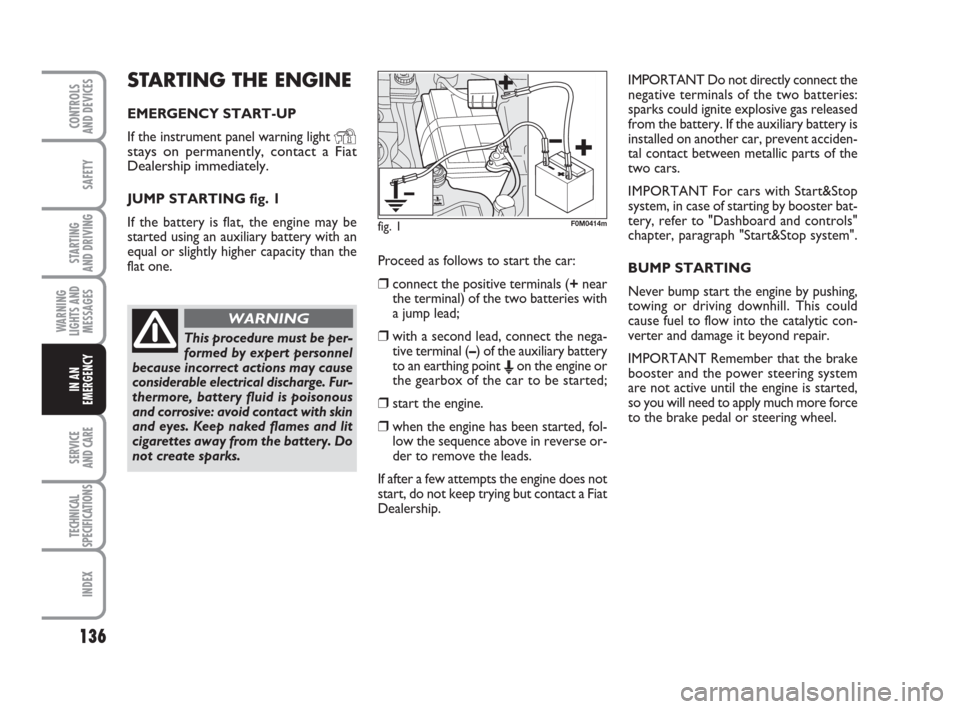
136
SAFETY
STARTING
AND DRIVING
WARNING
LIGHTS AND
MESSAGES
SERVICE
AND CARE
TECHNICAL
SPECIFICATIONS
INDEX
CONTROLS
AND DEVICES
IN AN
EMERGENCY
STARTING THE ENGINE
EMERGENCY START-UP
If the instrument panel warning light
Ystays on permanently, contact a Fiat
Dealership immediately.
JUMP STARTING fig. 1
If the battery is flat, the engine may be
started using an auxiliary battery with an
equal or slightly higher capacity than the
flat one. Proceed as follows to start the car:
❒connect the positive terminals (+near
the terminal) of the two batteries with
a jump lead;
❒with a second lead, connect the nega-
tive terminal (–) of the auxiliary battery
to an earthing point
Eon the engine or
the gearbox of the car to be started;
❒start the engine.
❒when the engine has been started, fol-
low the sequence above in reverse or-
der to remove the leads.
If after a few attempts the engine does not
start, do not keep trying but contact a Fiat
Dealership.IMPORTANT Do not directly connect the
negative terminals of the two batteries:
sparks could ignite explosive gas released
from the battery. If the auxiliary battery is
installed on another car, prevent acciden-
tal contact between metallic parts of the
two cars.
IMPORTANT For cars with Start&Stop
system, in case of starting by booster bat-
tery, refer to "Dashboard and controls"
chapter, paragraph "Start&Stop system".
BUMP STARTING
Never bump start the engine by pushing,
towing or driving downhill. This could
cause fuel to flow into the catalytic con-
verter and damage it beyond repair.
IMPORTANT Remember that the brake
booster and the power steering system
are not active until the engine is started,
so you will need to apply much more force
to the brake pedal or steering wheel.
This procedure must be per-
formed by expert personnel
because incorrect actions may cause
considerable electrical discharge. Fur-
thermore, battery fluid is poisonous
and corrosive: avoid contact with skin
and eyes. Keep naked flames and lit
cigarettes away from the battery. Do
not create sparks.
WARNING
fig. 1F0M0414m
135-166 ACTUAL 1ed EN 26-07-2010 16:00 Pagina 136